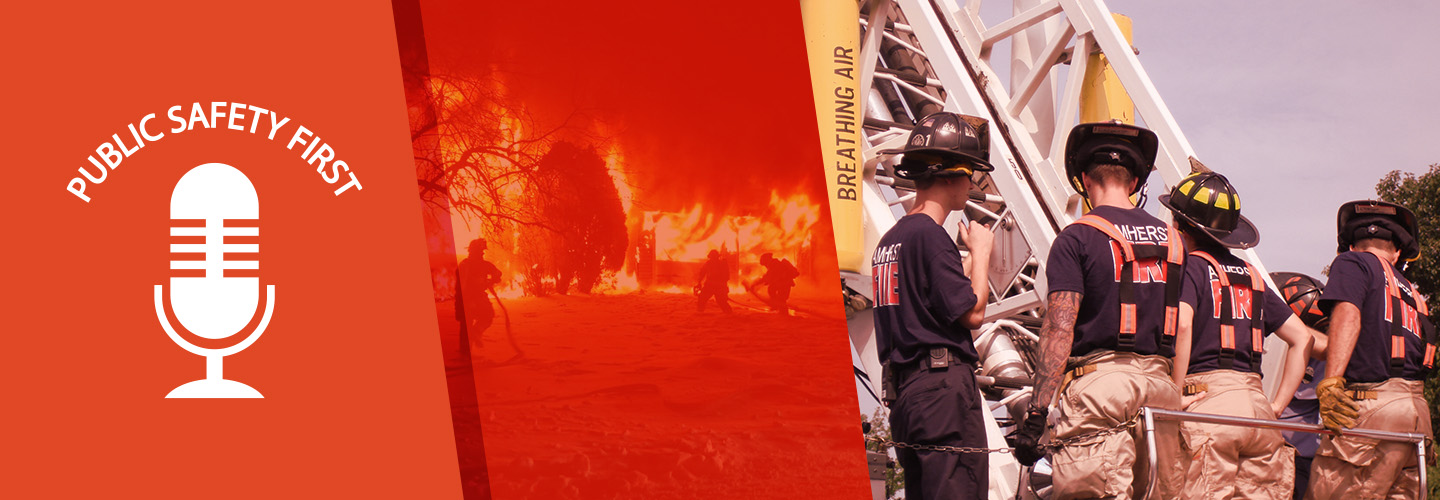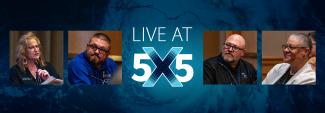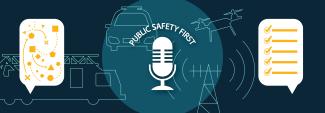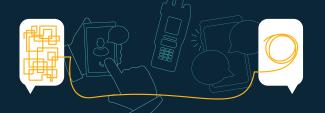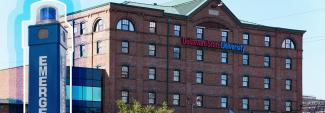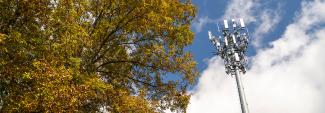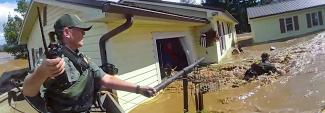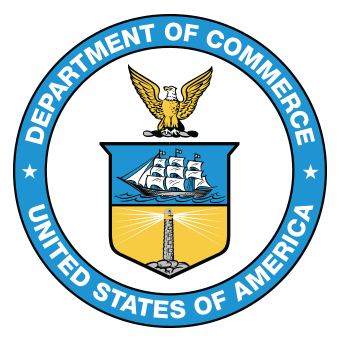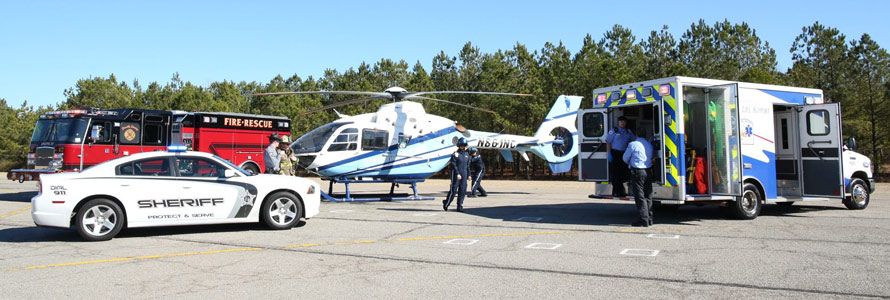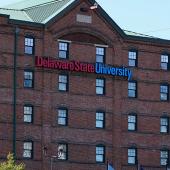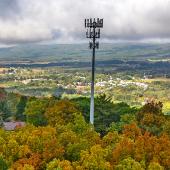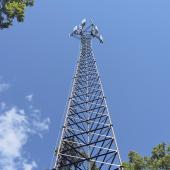Summary
Guest
Bruce Fitzgerald, Senior Public Safety Advisor, FirstNet Authority
Lindsay Stromgren, Fire Chief, Amherst Fire Department, Massachusetts
Transcript
Preview
Narrator: You're listening to Public Safety First, a podcast to help you learn about the First Responder Network Authority and how you can be part of the future of public safety technology.
And now, your host.
Narrator: You're listening to Public Safety First, a podcast to help you learn about the First Responder Network Authority and how you can be part of the future of public safety technology.
And now, your host.
Bruce Fitzgerald: Welcome to the Public Safety First podcast. I'm Bruce Fitzgerald, a senior public safety advisor with the FirstNet Authority, and I'm joined today by Chief Lindsay Stromgren from the Amherst Fire Department in Massachusetts. Chief Stromgren grew up in Amherst and has been with the Amherst Fire Department for more than 40 years. He began his career with the department as a volunteer student firefighter and rose up through the ranks to become the chief. He recently helped bring FirstNet to public safety in Amherst. Responders are now using the network for interoperability, expanded coverage, and during major planned events at the local university. Thanks for joining us today, Chief Stromgren. Welcome to the podcast.
Chief Lindsay Stromgren: Good morning, Bruce. Great to be here.
Bruce Fitzgerald: Tell us a little bit about yourself, the department in Amherst, and some of the unique challenges that your teams face.
Chief Lindsay Stromgren: Yeah, sure. Like you said, I've been here with Amherst since I was a student at UMass, about 40 years ago. Our department is what I call a very busy small department. So, we are a combination department of about 45 full time firefighter paramedics. We do run the paramedic ambulance services, as well as the fire, of course. We also have a traditional part time paid call force and a student volunteer force, which is made up of about 30 UMass students. And we provide fire and EMS coverage to the town of Amherst, the University of Massachusetts, which is the flagship UMass campus here in the state, and two small liberal arts colleges, Amherst College and Hampshire College in our town. And then we also do primary EMS to three of our neighboring communities.
Bruce Fitzgerald: Wow, you got a lot going on there.
Chief Lindsay Stromgren: Yep. Like I said, we're a very busy small department. We only have about 8 or 9 full time firefighters on duty, and we're doing just under 7,000 calls a year. About 80% of those being EMS calls. And obviously the colleges keep us busy during the school year, but we're pretty active year-round.
Bruce Fitzgerald: Excellent. You brought the department over to FirstNet over the past couple of years. Why did you choose to join FirstNet in the first place?
Chief Lindsay Stromgren: About three years ago, our community decided they wanted to start a third public safety agency. So, there was a mandate given to our town manager to create this third agency. He had a year to do it. And as you can imagine, creating a new agency from scratch has a lot of logistical hurdles, you know, hiring personnel, building policies, vehicles, etc. and of course, communications was one of those challenges — how they were going to communicate. They were going to be dispatched by our 9-1-1 PSAP center. So, they had to have communications just like police and fire. So, myself and a gentleman at our IT department were tasked with that. Originally, the organizers thought, well, we can just use the police radio frequency, the LMR that they use. Quickly it became apparent that wasn't going to work. Then they said, well, you can use the fire-EMS. You know, on a similar note, our VHF LMR system, we weren't able to take another agency on that. This wouldn't work. So, then they were going to go out and get their own radio system, which of course sounds great, but as anybody in the business knows, between the cost of infrastructure and just getting radio frequencies, that's not really practical for a small community like ours. So, the suggestion was made by our IT department that we look at FirstNet. We ordered up a couple of FirstNet devices and did the tried and true, "Can you hear me now? Can you hear me now?" testing around the town and had great results. And then, that led us into adopting push-to-talk for that new group, which, by the way, is called CRESS. So, we got them up and running within the year with FirstNet push-to-talk, and that served their needs very well. And then from there we branched it out to fire and now ultimately to the police department.
Bruce Fitzgerald: Wow, that is great that you were able to get that up and running so quickly. That's a lot to do in a short amount of time to basically create a department from scratch. Did you notice any challenges during that whole process with the communication side of it, either in testing devices or training people on how to use the push-to-talk system?
Chief Lindsay Stromgren: Yeah. Training not so much, to be honest. That was fairly intuitive, which is one of the things I like about it. I've been dealing with radio communications here in Amherst for well over 20 years. And as technology has gotten more and more advanced — in a good way — in terms of what we can do, I think there's been a disconnect, honestly, with what I call the end user, which are your police officers, your firefighters, your EMTs out in the street. We're giving them $7, $8000, $9,000 portable radios that literally may have 30 or more buttons and knobs and submenus and other things on them that honestly, they don't know how to use. And so, it creates interoperability and day-to-day challenges, and we're paying for things that aren't getting used.
So, what your police officer, your firefighter wants honestly, is push-to-talk. Literally — they want to be on 1 or 2 channels, push-to-talk. That's what they want. And that's what you can get with the FirstNet devices. Despite all the vast options they have behind the scenes, it can be very simple in terms of what you give to the end user. So no, from a training standpoint, we didn't have any difficulties.
I think the biggest challenge and what I would want to get out to other people there, especially smaller communities, is you have to look at the financial side of it. You know, when you're talking about FirstNet and FirstNet devices, you're essentially talking about getting a cell phone and with that comes a monthly subscription fee. So, when you start to look at how many devices, let's say you need ten devices to start for a particular department. You're taking on a monthly subscription fee for ten devices. And, you know, somebody looking at which we had happen at town hall, like, whoa, that's going to be this much a month, this much a year. That's a lot of expense. And that's true. You can look at it that way, but it's not the way you should look at it. The way you should look at it is if I go buy a portable radio these days for public safety, you're literally talking 6, 7, 8, $9,000 for a single handheld portable radio. If you take the example I just used, ten devices, let's just say I'm throwing some numbers out here, but $25, $30 a month for a subscription fee for FirstNet.. And one of the key things here is that's coming out of my operating budget versus a capital procurement. If I want to go buy $80-100,000 worth of radios, that has to be put into a capital purchase plan. It has to go through a budgetary process. It takes about a year to do anything like that. Whereas to start to get FirstNet devices online, I can start with a couple today. So, it's a mindset that I think people have to look at when you're starting up, that you're really doing this under an operating budget versus a capital budget. So, once we got through that, honestly, from a technological standpoint, things went very well for us. It was just getting through that initial financial step.
Bruce Fitzgerald: Yeah, you nailed it. And that's not even to talk about if you were to lose or run over with a fire truck or something gets stolen. I mean, now you're out an $8,000 radio that you've got to replace. So, it's a lot easier to replace a regular cell phone handset.
Chief Lindsay Stromgren: And that's a really great point. Yes. If we were to damage it, lose it, you call up and you get another device sent to you. You know, we started with a particular model, manufacturer model device. And it worked great for some of our needs. But then we were looking at other devices like, you know, this is going to be better for us. And now the police have decided they want another model. I was migrating towards the ones that more closely resemble a portable radio versus a full-fledged smartphone. And we had already purchased a bunch of devices as part of our subscription. And we wanted to change because we'd already had them for over a year. We were able, just like when you replace your cell phone, we were able to do that with our FirstNet devices. So, we were able to change midstream. You can't do that obviously, if you're buying portable radios.
Bruce Fitzgerald: Yeah, we see that a lot too, with public works departments and schools and other agencies that support public safety, but they don't need the full blown, you know, hardened device that a police officer or firefighter might need.
Chief Lindsay Stromgren: Yeah, exactly.
Bruce Fitzgerald: So, that actually brings me to our next question. How are you using FirstNet in Amherst during day-to-day response operations?
Chief Lindsay Stromgren: Sure. So, you know, I'll expand a little bit on when we started. We got our CRESS team up and running, and we were so impressed then with the coverage, which essentially was seamless border to border in our town, that we started to explore it for the fire department. We do have some gaps in our LMR system, some are geographical or a little bit hilly. A lot of our LMR gaps for our primary radio channels are in critical buildings on our UMass campus. We have a 10,000-seat stadium on the campus where they hold concerts and sporting events. That's a radio dead zone, and we have some other places around town. So, we started to explore how FirstNet was going to work for us there. And again, we found essentially seamless coverage. We just couldn't find any dead spots. So, that struck us as, hey, this could be useful for us in our fire department operations. So, we bought some devices for the fire department, and we went a step further and bought the gateway so we could integrate it into our existing LMR system. So, now with our FirstNet devices, we have our private FirstNet talk groups, but we also can tie into our LMR system. So, you go to any of those places I just mentioned — the stadium, the arena, other places where we had dead spots, now we no longer have dead spots. So, when we have an event planned or otherwise where we put teams in there, we're issuing them the FirstNet devices, not the regular portable radios because we know that they can transmit in and out of those areas.
Bruce Fitzgerald: You're steps ahead of a lot of agencies that are just adopting right now and using it for their regular cellular communications. So, it's great. I'm so glad to hear that all of these things are working for you and working as well as they are.
Chief Lindsay Stromgren: And I'm glad you mentioned that, because if I was trying to do a quick tutorial for somebody about what FirstNet is and what it can offer you, anybody who knows what FirstNet is in their head, it's another network, right? That's all it is. And they might know it's for public safety. And then there's the next level. They understand it gives you priority and has some other advantages. And then yeah, the next step is that you can use push-to-talk, but then it's yet another level that you can tie it into your LMR system and then beyond. There are so many things available.
Bruce Fitzgerald: Yeah. Expanded capabilities. What are your folks in the field saying about it? How is it working for them? Tell us about that.
Chief Lindsay Stromgren: Yeah. I mean, it's all essentially positive when we give people these devices to use at some of these events. They're experiencing, I'll say, perfect coverage. There is no gaps there. Anyone that's been around here for a while, they know in these places that our portable radios just don't work, and you have to do silly things like go stand by the window or go stand out, you know, outside the door to talk to somebody with the traditional LMR portables in some of these locations. They know now that with the FirstNet devices, they're going to work.
We have an event here in Amherst every year. It's a non-sanctioned, organic event that just happens with our college students called Blarney Blowout. It's the Saturday before Saint Patrick's Day, and they all go on spring break. And essentially, you get about 5,000 students getting together in a very, very small area, shoulder to shoulder in this apartment complex for you know, a day of partying. And over the years, you know, it's had some issues, police issues with arrests. Recently, it's been more medical issues, alcohol intoxications, traumas. This year, we had some crowd surge concerns. And that particular area of town, we have some LMR issues in terms of coverage. But what we saw two years ago is, we had already started to migrate to FirstNet. So, all of my people from the fire department had FirstNet devices down there. The police department and other people that were working down there were on whatever carriers they were using. And if you can just envision 5,000 students all in one area partying, what do they all want to do? They all want to stream what they're doing, right. So, you've got 5,000 students in this area streaming, and that just bogs down and kills the bandwidth on every single carrier. So, the people that were trying to talk and do other things from that location, even text, on regular carriers were not able to do it. Our FirstNet devices kept up, running 100%, and even to the point that we actually use a FirstNet gateway to stream video from a drone. We fly a drone now over this event and feed the footage back to our emergency operations center. We're using that over a FirstNet-enabled gateway. That stayed live for 4.5 hours streaming video, and we had perfect communication. So that's another success story for us.
But then our police department working with us saw that. And so now, a year later, they're all on board. They're buying the devices. And we had had the forethought back when we put the gateway in for the fire LMR, we paid a little bit extra and put the police LMR capability in there. So, now they have the same system that we do.
Bruce Fitzgerald: It's really neat when you see the lightbulb go on for other people, when they see it working in real time, and they realize that priority and preemption is there and it works, and that some of these solutions can cut through the challenges that they've had year after year.
Chief Lindsay Stromgren: Yeah, totally. And we've shown the success with covering LMR gaps. And now we've shown the success of having the bandwidth and preemption and being able to get your messages through.
Bruce Fitzgerald: How about working with surrounding agencies? So, we've talked about working with other agencies and departments within the city, but do you also work with mutual aid partners from outside of town? Are they on FirstNet and have you taken steps to build them into your push-to-talk talk groups or anything like that?
Chief Lindsay Stromgren: You know, that's actually our current next step, if you will. We're working with one of our neighboring towns right now. We also provide the ambulance to them. It's one of the communities we cover. They just started to adopt FirstNet, and we're actually working with their chief right now so that we can have a shared talk group or be on each other's LMR. And we hope that other communities in the area will come online for that.
Bruce Fitzgerald: That's great. I mean, you mentioned earlier, how difficult it is to get new frequencies licensed. So, with push-to-talk, you have the ability to really mushroom those talk groups and relationships with your neighbors.
Chief Lindsay Stromgren: Yeah, totally. And again, if it's something I was trying to explain to somebody new to FirstNet, what it can do for you. It's giving you dozens of other channels that you can use just boom with that first device. So, the way that we have it set up right now in Amherst is we have a private fire talk group set up all the time that we can use for events or amongst the administration. And we have, of course, our LMR talk group tie in. The police have the same thing. They have a private police channel and their LMR. The CRESS team, they have their private talk group. And then we just recently this winter created a town-wide talk group. So, if we have an event, whether it's pre-planned or some emergency, we have a common talk group we can all go to. So, you know, like you said, we're leveraging that to have all these different channels or talk groups available to us. And the beauty of it is, any of our FirstNet administrators here in town can create new talk groups on the fly if they ever needed for an emergency that cropped up.
Bruce Fitzgerald: Yep. Plus, you're getting more than just voice. You can send video, text, pictures if you need to. So, there's a lot of capability that's also built into that beyond just a voice radio.
Chief Lindsay Stromgren: No, totally. Anything a smartphone can do; it can do and more. And I should have mentioned, you know, our ambulances and fire engines, we have hotspots in all of them for, you know, using laptops and transmitting data back and forth from scenes, doing patient reporting for EMS, things like that. We switched all those over to the FirstNet platform as well, so that wherever they are, whether they're in our town or they're in another town, they're getting that priority and using the FirstNet system.
Bruce Fitzgerald: Fantastic. How about some of your other events that you all manage? I know there's the Seven Sisters Trail Race that goes through a pretty remote part of the region, and then you've got some big events with graduations and sporting at the college and that sort of thing.
Chief Lindsay Stromgren: The Seven Sisters Trail Race, that's an annual event where about 3-500 runners do a seven mile run across a mountain range and seven miles back again. So, very rugged terrain. And you can imagine that kind of running, 14 miles total through up and down across a mountain top, can bring a lot of EMS issues. And it's very rugged terrain. It's not somewhere you can just drive a vehicle to. So, that's been going on now for about ten years. And for years we struggled, honestly, with radio communications. Our simplex channels can't go that whole distance one end to the other. Our primary duplex channels could hit some parts of the mountain, but not all parts of the mountain. So, we tried different solutions over the years. We set up some radio repeaters down below the mountain in different configurations with some decent but, you know, mixed success. We could never quite hit every single spot because what we do is we place EMS teams, every so often across the mountain so they can get to a runner relatively quickly if they go down.
So, two years ago for that Seven Sisters road race, we switched over from LMR to the FirstNet devices. Our assistant chief in the command post up on the mountain range had one, all the teams stationed across the seven miles of the race had one, and, you know, once again, I gotta say, we had seamless coverage. So, they're using a private talk group channel to talk amongst the teams and to deploy teams out to where they have a report of runners down. And then the incident commanders using our LMR talk group to talk to our dispatch to request ambulances. So, that's gone very well these past two years.
Bruce Fitzgerald: That's great. You are squeezing the most that you can out of that system!
Chief, I want to thank you for really embracing FirstNet and being open to all of the different things that it can do and all the different technologies that are being enabled now with the development of this network. It sounds like it's working great for you. Are there any other capabilities that you're looking to adopt or things that would be useful to your agency or people are asking for?
Chief Lindsay Stromgren: Yeah. I mean, I think at first I should mention a couple other things that we are already using that I haven't mentioned yet. We are using the FirstNet web dispatch console, and that worked out great for us. We just started using this for the first time for that Blarney Blowout I spoke about earlier. Wherever we set up an EOC or a command post, in this case, we had an EOC set up on the UMass campus. We open up our laptop, we connect to the web dispatch console. And I was actually the one staffing that this year. You know, I'm able to listen to and talk as needed to the police department, the fire units, the CRESS units that I had to. So, we found that to be a really valuable addition is to have that ability to really set up on the fly wherever we need to for an EOC or a command post that dispatch console that will talk to all of those talk groups that we have set up.
We're also using eBridge now over FirstNet for our medical reporting to our trauma center in the nearby city.
And in terms of looking for future things, I don't think we're fully using the mapping capabilities right now. I think we want to do more of that as we do more with our drone program. There's a lot out there. Each year we're adopting a little bit more and leveraging a little bit more in terms of our day-to-day and special event operations.
Bruce Fitzgerald: Yeah, the technology is developing so quickly, and it's great to hear that your responders and your teams are open to trying all these new things when they come out. Give a lot of credit to you guys for being willing to try new technologies.
Chief Lindsay Stromgren: I have a good department. They want to try the new stuff. They want to improve things. So that works well with us.
Another thing I didn't mention yet, as you try to tell people all about what you can do besides having the push-to-talk devices, me and my admin team here in the fire department and also at the police department, we have the mission critical PTT on our cell phones. And the advantage of that is I do not carry, you know, a heavy $8,000 portable with me everywhere I go, whether it's meetings or to the store or to a meal or home on the weekends or whatever. I'm not carrying that big portable, but I'm always going to have my iPhone with me. So, if some event suddenly crops up either in front of me that I need to get involved in, or there's some major event happening in town that I'm trying to get back for, even though I may not have a portable nearby, I can open that up on my phone and it functions for all intents and purposes, just like my portable radio. I can be listening to my LMR channel. I can be talking on it. I can listen to the police as well. So, you know, that's yet another advantage of how you can build this system out and, you know, sort of a force multiplier to help with your day-to-day operations.
And I actually, I was in Washington, D.C., waiting for a flight, coming back from a conference, and they had a fire in my town. And I'm not going to manage the fire obviously remotely, but I sure do want to listen to hear what's going on. So, I was able to open up that FirstNet and monitor my troops and hear what was happening. So, there's lots of things like that that you don't think about at first, but really end up being very valuable.
Bruce Fitzgerald: Yeah, we hear that a lot, the ability to travel and be outside of your normal radio footprint and still use the push-to-talk system. And people say it sounds like you're right at home.
Chief Lindsay Stromgren: Yep. Exactly.
Bruce Fitzgerald: Yep. Is there anything else you'd like to share with public safety agencies that are thinking about joining FirstNet?
Chief Lindsay Stromgren: Yeah, I think the biggest takeaway I'd want to give anybody who hasn't gotten involved with FirstNet yet is don't be scared off by it. When you talk about a new radio system or buying any kind of equipment, you have to do a ton of research. Larger cities, they have people that deal with their radio communications as their full time job. Your smaller communities, you know, you have a police chief or fire chief, a small group of responders, they might be overwhelmed by something like this. The reality is, you go into the office Monday morning, you can find and call up your FirstNet rep. You can order a couple devices, have them in your office a few days later. You can immediately go out there and start testing it and see what it's all about. See what the coverage is, see how the devices work, and then if it works for you and you like it, you've got your first couple devices. You can order a few more. If you decide you want to connect your LMR, you can make that small investment for the gateway, and it's very much a building block to build this up versus having to plan for it for a whole year. You can start this under your operating budget with a very small investment and then just build it from there. So, don't be scared off by it.
Bruce Fitzgerald: It's such a great point and how scalable it is. And, you know, if somebody gets into push-to-talk and they find out it just isn't what they need or it isn't working for them, it's easy to switch that off too.
Chief Lindsay Stromgren: Exactly, yep.
Bruce Fitzgerald: Yep. All right. Fantastic. Chief Stromgren, thank you so much. Thank you for your 40 years of service. Thank you for really embracing and being willing to try new technology and really getting the most out of FirstNet for your community. Thanks for being with us today. And thank you all for listening to our Public Safety First podcast.
Chief Lindsay Stromgren: Great. Thank you very much. Appreciate it.
Narrator: Thanks for listening today. We're excited to have you join our podcast community. Make sure to subscribe on iTunes, SoundCloud, and YouTube. You can learn more about the First Responder Network Authority at FirstNet.gov and learn about FirstNet products and services at FirstNet.com.


